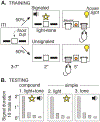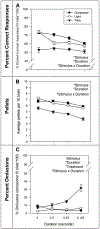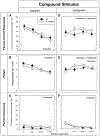Performance on a modified signal detection task of attention is impaired in male and female rats following developmental exposure to the synthetic progestin, 17α-hydroxyprogesterone caproate
- PMID: 34303952
- PMCID: PMC8988016
- DOI: 10.1016/j.yhbeh.2021.105039
Performance on a modified signal detection task of attention is impaired in male and female rats following developmental exposure to the synthetic progestin, 17α-hydroxyprogesterone caproate
Abstract
Based on evidence that the developing mesocortical dopamine pathway is sensitive to progestins, in the present study we tested the hypothesis that attention, a fundamental component of successful cognitive behavior, is disrupted by developmental exposure to the synthetic progestin, 17-α-hydroxyprogesterone caproate (17-OHPC). To assess attentional impairments, a modified signal detection task was utilized with three stimulus modalities: compound (light and tone), light alone, and tone alone, for four stimulus durations (2, 0.5, 0.25, 0.125 s). Adult rats were trained to push one lever if they detected the stimulus, and another lever if the stimulus was not presented. 17-OHPC animals were able to attend to the task, as evidenced by similar correct responses as controls. However, as the task became increasingly difficult at shorter durations, 17-OHPC animals made significantly more omissions compared to controls, suggesting that 17-OHPC treatment may disrupt attentional processes and/or delay response time. These findings add to the current body of literature demonstrating that exposure to 17-OHPC during development produces deficits in cognitive behavior in adulthood. These results may inform potential risks associated with 17-OHPC treatment in pregnant women with a history of preterm delivery who are commonly recipients of such treatment.
Keywords: 17-α-hydroxyprogesterone caproate; Attention; Mesocortical dopamine pathway; Omissions.
Copyright © 2021 Elsevier Inc. All rights reserved.
Figures





Similar articles
-
Developmental exposure to the synthetic progestin, 17α-hydroxyprogesterone caproate, disrupts the mesocortical serotonin pathway and alters impulsive decision-making in rats.Dev Neurobiol. 2021 Sep;81(6):763-773. doi: 10.1002/dneu.22847. Epub 2021 Aug 13. Dev Neurobiol. 2021. PMID: 34318625 Free PMC article.
-
Developmental exposure to 17α-hydroxyprogesterone caproate impairs adult delayed reinforcement and reversal learning in male and female rats.J Neuroendocrinol. 2020 Jun;32(6):e12862. doi: 10.1111/jne.12862. Epub 2020 Jun 2. J Neuroendocrinol. 2020. PMID: 32485009 Free PMC article.
-
Developmental 17-OHPC exposure disrupts behavior regulated by the mesocorticolimbic dopaminergic system in rats.Pharmacol Biochem Behav. 2024 Dec;245:173886. doi: 10.1016/j.pbb.2024.173886. Epub 2024 Oct 3. Pharmacol Biochem Behav. 2024. PMID: 39368616
-
Prevention of preterm delivery with 17-hydroxyprogesterone caproate: pharmacologic considerations.Semin Perinatol. 2014 Dec;38(8):516-22. doi: 10.1053/j.semperi.2014.08.013. Epub 2014 Sep 23. Semin Perinatol. 2014. PMID: 25256193 Free PMC article. Review.
-
Prevention of preterm birth with vaginal progesterone or 17-alpha-hydroxyprogesterone caproate: a critical examination of efficacy and safety.Am J Obstet Gynecol. 2016 Jan;214(1):45-56. doi: 10.1016/j.ajog.2015.10.934. Epub 2015 Nov 10. Am J Obstet Gynecol. 2016. PMID: 26558340 Review.
Cited by
-
Sensorimotor Development in Rat Neonates Exposed to 17-α-Hydroxyprogesterone Caproate: A Progestin Used in Obstetrics.Neuroendocrinology. 2025;115(8):678-688. doi: 10.1159/000546356. Epub 2025 May 21. Neuroendocrinology. 2025. PMID: 40398404
-
Developmental exposure to the synthetic progestin, 17α-hydroxyprogesterone caproate, disrupts the mesocortical serotonin pathway and alters impulsive decision-making in rats.Dev Neurobiol. 2021 Sep;81(6):763-773. doi: 10.1002/dneu.22847. Epub 2021 Aug 13. Dev Neurobiol. 2021. PMID: 34318625 Free PMC article.
-
Developmental exposure to 17-α-hydroxyprogesterone caproate disrupts decision-making in adult female rats: A potential role for a dopaminergic mechanism.Horm Behav. 2024 Jul;163:105550. doi: 10.1016/j.yhbeh.2024.105550. Epub 2024 Apr 25. Horm Behav. 2024. PMID: 38669977 Free PMC article.
References
-
- Attardi BJ, Zeleznik A, Simhan H, Chiao JP, Mattison DR, Caritis SN, 2007. Comparison of progesterone and glucocorticoid receptor binding and stimulation of gene expression by progesterone, 17-alpha hydroxyprogesterone caproate, and related progestins. Am. J. Obstet. Gynecol 197. 10.1016/j.ajog.2007.05.024. - DOI - PMC - PubMed
Publication types
MeSH terms
Substances
Grants and funding
LinkOut - more resources
Full Text Sources

